





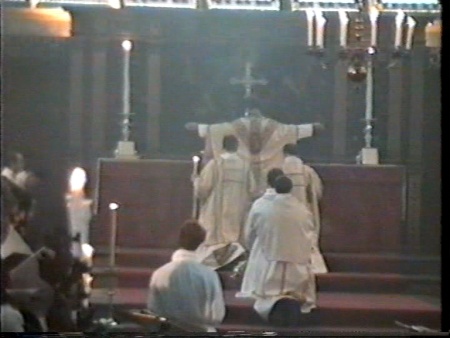 The version of the Roman Rite used in southern and central England before the Reformation, the 'Sarum (ie Salisbury) Use' (there was also a 'York Use' and others), was celebrated in the late 1990s in Keble College Chapel by Fr Sean Finnegan, then of the Oxford Oratory, now of the diocese of Arundel and Brighton. Shawn Tribe has posted some pictures and commentary on his blog; for his full post see here.
The version of the Roman Rite used in southern and central England before the Reformation, the 'Sarum (ie Salisbury) Use' (there was also a 'York Use' and others), was celebrated in the late 1990s in Keble College Chapel by Fr Sean Finnegan, then of the Oxford Oratory, now of the diocese of Arundel and Brighton. Shawn Tribe has posted some pictures and commentary on his blog; for his full post see here.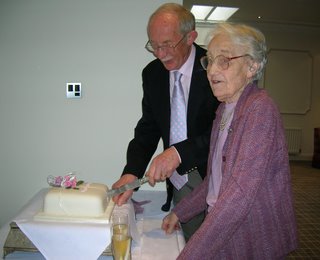 Penelope Renold, 5th May 1916-25th June 2006
Penelope Renold, 5th May 1916-25th June 2006
Miss Penelope Renold, one of
Penny was received into the Church in 1936, having come into contact with Catholicism while at school in
Like many Catholics, Penny found the liturgical changes following the Council a shattering experience. At a thinly attended meeting in the House of Commons, called by Catholic laity concerned by the situation, she was inspired by Michael Davies to become involved in the infant movement for the preservation of the Traditional liturgy. She was active in helping priests, preserving discarded books, vestments and sacred vessels, a nd establishing the St Pius V Information Centre, an apostolate she sold in 1978 to what is now the
nd establishing the St Pius V Information Centre, an apostolate she sold in 1978 to what is now the
Since moving to Oxford in 1981, Penny continued to work tirelessly for the Traditional Mass, most recently lending her collection of vestments and church silver for Fr Andrew Southwell’s Oxford Masses, where she was in charge of setting up and putting away the necessary things in our various Mass venues.
Not one of nature’s optimists, Penny responded to the tremendous challenges faced by all of her generation with the more practical characteristics of unshakable fidelity to the Church’s Tradition, unlimited energy and organisational ability, and iron determination. She inspired great affection among the Oxford Traditional community, and it was providential that her splendid 90th Birthday celebration brought many members of her extended family together with her Oxford friends, only a few weeks before her death. Her birthday fell on the feast of St Pius V, which was marked this year by May’s First Friday Mass, sung by Fr John Saward in Penny’s own parish church, SS Gregory and Augustine. It would have given her some satisfaction to have avoided the embarrassment of the short piece of appreciation which had been planned for the August issue of Mass of Ages. She will be greatly missed. May she rest in peace.
P.S. There is an interesting article on Penny's remarkable grandfather, Hans Renold, here.
Prayer Cards for Penny are available from me on request: send your postal address to joseph.shaw@philosophy.ox.ac.ukDecree Erecting the Priestly Fraternity Of Saint Peter
18 October 1988
…
The members of the Priestly Fraternity of St. Peter, as well as other priests who are guests in houses of the Fraternity or who exercise the sacred ministry in their churches, are conceded the use of the liturgical books in force in 1962.
...
Anything to the contrary notwithstanding.
Given at
Decree concerning the Personal Apostolic Administration of “St John Mary Vianney”
...
...
Given at Rome, from the seat of the Congregation for Bishops, 18th Janurary 2002
John Baptist Card. Re
Prefect
+ Francis Monterisi
Secretary
Interview given by Archbishop Burke,
“However, I did have some correspondence with Dario Cardinal Castrillon Hoyos, the president of the Ecclesia Dei Commission, because a question was raised to me regarding the validity of the celebration of the other sacraments other than the Holy Mass according to the rites in force in 1962.
Apparently, among some people somewhere, this question arose. They believed there was no permission to do this, and what is more, if a bishop or priest was doing this, that these celebrations were not valid.
Now, as a canonist, and being somewhat versed in sacramental theology, I knew that this could not be possible because these rites were celebrated for centuries, and were valid celebrations. It could be that if the Pope had forbidden it, that it wouldn’t be licit. In other words, it wouldn’t be licit to celebrate those rites, but they would certainly be valid.
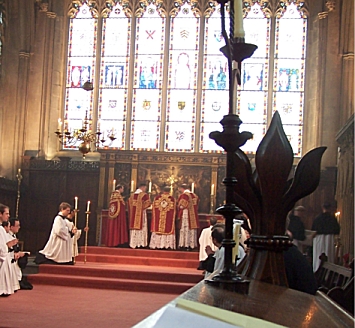
"We are pleased to report that the CIEL 2006 colloquium held in Oxford this past September 13th-16th, 2006, was a great success in all regards, with more than 160 delegates in attendance (excluding those who solely attended the liturgies), a significant number of clergy and religious, and a wide representation of nations present.
The various liturgies and papers presented at the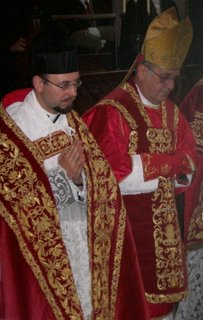 colloquium present a manifest and evident excellence in the celebration and study of the Roman liturgical
colloquium present a manifest and evident excellence in the celebration and study of the Roman liturgical 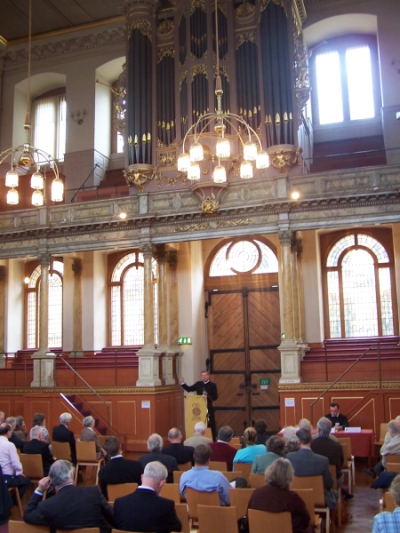 tradition."
tradition."
He continued, "the answers given by the nine Cardinals in 1986 was 'No, the Mass of Saint Pius V has never been suppressed'."
"the nine Cardinals unanimously agreed that no bishop may forbid a Catholic priest from saying the Tridentine Mass."
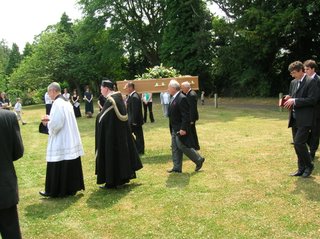


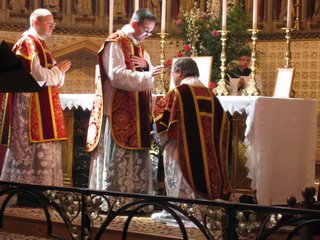 processed to the site of the Castle gallows, outside Nuffield College, where Blessed George Napper (or Napier), was similarly hanged, drawn and quartered in 1610.
processed to the site of the Castle gallows, outside Nuffield College, where Blessed George Napper (or Napier), was similarly hanged, drawn and quartered in 1610.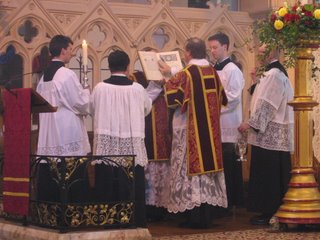
The music was  provided by the Oratory Choirmaster, Mr Edward de Rivera, and members of the Oratory Choir. The Ordinary of the Mass was the Mass for Five Voices by the great William Byrd, whose music brought so much comfort to Catholics in the period of the Elizabethan persecution. He was born in Lincoln in 1543? and died at Stondon Massey, Essex on 4 July 1623. His output of Latin works: Motets, Gradualia etc was considerable to say nothing of his secular songs and madrigals and English settings for the Reformed Church. Despite his steadfast devotion to his Catholic Faith, he was a great favourite of Queen Elizabeth.
provided by the Oratory Choirmaster, Mr Edward de Rivera, and members of the Oratory Choir. The Ordinary of the Mass was the Mass for Five Voices by the great William Byrd, whose music brought so much comfort to Catholics in the period of the Elizabethan persecution. He was born in Lincoln in 1543? and died at Stondon Massey, Essex on 4 July 1623. His output of Latin works: Motets, Gradualia etc was considerable to say nothing of his secular songs and madrigals and English settings for the Reformed Church. Despite his steadfast devotion to his Catholic Faith, he was a great favourite of Queen Elizabeth.
At 2pm, after a break for lunch, Br Anton Webb, assisted by Gordon  Dimon and three acolytes with processional cross, silk banner, and megaphone, led a procession from the top of New Road, past the Castle, to the site of Bl George Napper’s execution, approximately where the Memorial Gate of Nuffield College now stands. Forty people came on the procession, which was an impressive witness to the Faith. At Nuffield a large gallows, with a single noose hanging from it, marked the procession’s goal, where we completed chanting the
Dimon and three acolytes with processional cross, silk banner, and megaphone, led a procession from the top of New Road, past the Castle, to the site of Bl George Napper’s execution, approximately where the Memorial Gate of Nuffield College now stands. Forty people came on the procession, which was an impressive witness to the Faith. At Nuffield a large gallows, with a single noose hanging from it, marked the procession’s goal, where we completed chanting the 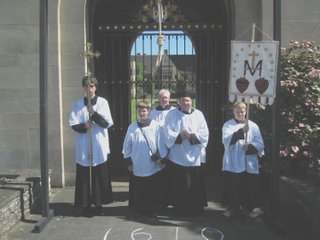 Litany of the Saints. We paused there while a contemporary account of Napper’s execution was read out, and then processed back to the Oratory, singing the Te Deum, the Canticle of the Three Young Men, and vernacular hymns (including Faith of Our Fathers), and reciting five decades of the Rosary.
Litany of the Saints. We paused there while a contemporary account of Napper’s execution was read out, and then processed back to the Oratory, singing the Te Deum, the Canticle of the Three Young Men, and vernacular hymns (including Faith of Our Fathers), and reciting five decades of the Rosary. At 4pm Fr Dominic Jacob celebrated Benediction of the Blessed Sacrament in the Oratory, bringing the pilgrimage to a close. Thanks are due to all those who came to honour our glorious predecessor in the Faith, and particularly to the Fathers of Oxford Oratory, who gave so much of their time as well as their church for this occasion.
At 4pm Fr Dominic Jacob celebrated Benediction of the Blessed Sacrament in the Oratory, bringing the pilgrimage to a close. Thanks are due to all those who came to honour our glorious predecessor in the Faith, and particularly to the Fathers of Oxford Oratory, who gave so much of their time as well as their church for this occasion.
I'm delighted to say that this important local event was covered by the Catholic Herald, and even got a mention in the Oxford Times.
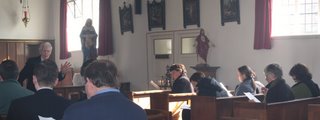
 ipts, and the symbols used in the Liber Usualis. I am sure we all learnt a great many things we never knew we didn’t know, as well as being given very practical help and coaching in singing the chosen pieces. After a hearty hot lunch provided by Lucy Shaw at the Presbytery, we prepared the very beautiful Mass IV, and the propers for the Mass of St Gregory the Great, who, not content with converting the English, gave his name to the Chant and, with St Augustine of Canterbury, is the patron of the church. Mass was expertly MCed by David Forster, and the schola, conducted by Dr
ipts, and the symbols used in the Liber Usualis. I am sure we all learnt a great many things we never knew we didn’t know, as well as being given very practical help and coaching in singing the chosen pieces. After a hearty hot lunch provided by Lucy Shaw at the Presbytery, we prepared the very beautiful Mass IV, and the propers for the Mass of St Gregory the Great, who, not content with converting the English, gave his name to the Chant and, with St Augustine of Canterbury, is the patron of the church. Mass was expertly MCed by David Forster, and the schola, conducted by Dr
Society of St Catherine of
28-29th October 2005
The Love of God in the Liturgy of the Eucharist past, present, and hoped for
On Saturday 25th June we had the first ever Latin Mass Society Pilgrimage to
ution, singing the Litany of the Saints. At the site itself we had a large gallows, with four nooses hanging from the cross-bar. With Fr Southwell and acolytes in cassocks and cottas, a processional cross and a silk banner, the procession of twenty five people was an impressive public witness to the Faith. The pilgrimage ended with Benediction in the Oratory, with prayers for the conversion of